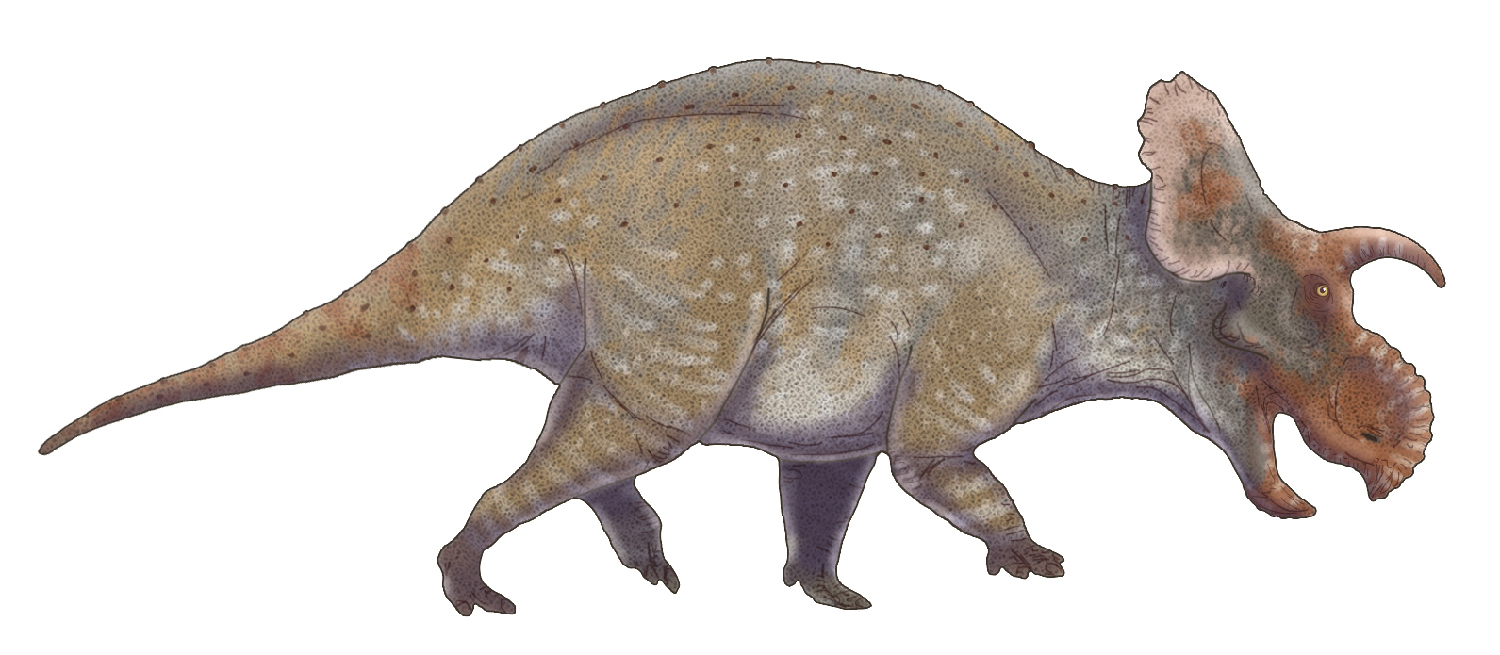|
Crittendenceratops
''Crittendenceratops'' (meaning "horned face from the Fort Crittenden Formation") is a genus of horned centrosaurine ceratopsid dinosaur from the late Campanian Fort Crittenden Formation of Arizona. It contains a single species, ''C. krzyzanowskii'', and represents the first species of dinosaur from the Fort Crittenden Formation to receive a formal scientific name. Description ''Crittendenceratops'' is distinguished by forward-curving, hook-like flanges located along the central portion of the top of the frill, "extensive" epiparietals located along the sides of the parietal portion of the frill, a thickening of the frill in the parietal portion, and a short, pronounced ridge on the surface of the squamosal portion of the frill. Classification ''Crittendenceratops'' was assigned to the Nasutoceratopsini (which also includes ''Avaceratops'', ''Nasutoceratops'', and ''Yehuecauhceratops''), a tribe of the ceratopsid subfamily Centrosaurinae, by Dalman ''et al.'' (2018). The c ... [...More Info...] [...Related Items...] OR: [Wikipedia] [Google] [Baidu] |
Crittendenceratops Size
''Crittendenceratops'' (meaning "horned face from the Fort Crittenden Formation") is a genus of horned centrosaurinae, centrosaurine ceratopsidae, ceratopsid dinosaur from the late Campanian Fort Crittenden Formation of Arizona. It contains a single species, ''C. krzyzanowskii'', and represents the first species of dinosaur from the Fort Crittenden Formation to receive a formal scientific name. Description ''Crittendenceratops'' is distinguished by forward-curving, hook-like flanges located along the central portion of the top of the frill, "extensive" Ceratopsia#Anatomy, epiparietals located along the sides of the parietal bone, parietal portion of the frill, a thickening of the frill in the parietal portion, and a short, pronounced ridge on the surface of the squamosal bone, squamosal portion of the frill. Classification ''Crittendenceratops'' was assigned to the Nasutoceratopsini (which also includes ''Avaceratops'', ''Nasutoceratops'', and ''Yehuecauhceratops''), a tribe of ... [...More Info...] [...Related Items...] OR: [Wikipedia] [Google] [Baidu] |
Fort Crittenden Formation
The Fort Crittenden Formation is a geological Formation (geology), formation in Arizona whose strata date back to the Late Cretaceous. Dinosaur remains are among the fossils that have been recovered from the formation.Weishampel, David B; et al. (2004). "Dinosaur distribution (Late Cretaceous, North America)." In: Weishampel, David B.; Dodson, Peter; and Osmólska, Halszka (eds.): ''The Dinosauria'', 2nd, Berkeley: University of California Press. pp. 574–88. . Vertebrate paleofauna Amphibians Archosaurs Bony fishes Cartilaginous fishes Lepidosaurs Teiid and anguid lizards are known from the formation. Turtles See also * List of dinosaur-bearing rock formations Footnotes References * Sullivan, R.M., and Lucas, S.G. 2006.The Kirtlandian land-vertebrate "age" – faunal composition, temporal position and biostratigraphic correlation in the nonmarine Upper Cretaceous of western North America " ''New Mexico Museum of Natural History and Science, Bulletin'' 35:7� ... [...More Info...] [...Related Items...] OR: [Wikipedia] [Google] [Baidu] |
Nasutoceratopsini
Centrosaurinae (from the Greek, meaning "pointed lizards") is a subfamily of ceratopsid dinosaurs, a group of large quadrupedal ornithischians. Centrosaurine fossil remains are known primarily from the northern region of Laramidia (modern day Alberta, Montana, and Alaska) but isolated taxa have been found in China and Utah as well. Defining features of centrosaurines include a large nasal horn, short supratemporal horns, and an ornamented frill projecting from the back of the skull. With the exception of ''Centrosaurus apertus'', all adult centrosaurines have spike-like ornaments midway up the skull. Morphometric analysis shows that centrosaurines differ from other ceratopsian groups in skull, snout, and frill shapes. There is evidence to suggest that male centrosaurines had an extended period of adolescence, and sexual ornamentation did not appear until adulthood. Centrosaurinae was named by paleontologist Lawrence Lambe in 1915, with ''Centrosaurus'' as the type genus. The cent ... [...More Info...] [...Related Items...] OR: [Wikipedia] [Google] [Baidu] |
Yehuecauhceratops Mudei
''Yehuecauhceratops'' (meaning "ancient horned face") is a genus of horned centrosaurine ceratopsid dinosaur from the Late Cretaceous of Coahuila, Mexico. It contains a single species, ''Y. mudei'', described from two partial specimens by Rivera-Sylva ''et al.'' in 2016 and formally named by Rivera-Sylva ''et al.'' in 2017. It was a small centrosaurine with a body length of , making it smaller than ''Agujaceratops'' and ''Coahuilaceratops'', the other two ceratopsids in its environment; the three may have been ecologically segregated. A ridge bearing a single roughened projection near the bottom of the squamosal bone, which probably supported a small horn, allows ''Yehuecauhceratops'' to be distinguished from other centrosaurines. Its affinities to nasutoceratopsin centrosaurines, such as ''Avaceratops'' and ''Nasutoceratops'', are supported by various morphological similarities to the former. Discovery and naming Specimens of ''Yehuecauhceratops'' were recovered during excava ... [...More Info...] [...Related Items...] OR: [Wikipedia] [Google] [Baidu] |
Centrosaurinae
Centrosaurinae (from the Greek, meaning "pointed lizards") is a subfamily of ceratopsid dinosaurs, a group of large quadrupedal ornithischians. Centrosaurine fossil remains are known primarily from the northern region of Laramidia (modern day Alberta, Montana, and Alaska) but isolated taxa have been found in China and Utah as well. Defining features of centrosaurines include a large nasal horn, short supratemporal horns, and an ornamented frill projecting from the back of the skull. With the exception of '' Centrosaurus apertus'', all adult centrosaurines have spike-like ornaments midway up the skull. Morphometric analysis shows that centrosaurines differ from other ceratopsian groups in skull, snout, and frill shapes. There is evidence to suggest that male centrosaurines had an extended period of adolescence, and sexual ornamentation did not appear until adulthood. Centrosaurinae was named by paleontologist Lawrence Lambe in 1915, with '' Centrosaurus'' as the type genus. The ... [...More Info...] [...Related Items...] OR: [Wikipedia] [Google] [Baidu] |
Centrosaurini
Centrosaurinae (from the Greek, meaning "pointed lizards") is a subfamily of ceratopsid dinosaurs, a group of large quadrupedal ornithischians. Centrosaurine fossil remains are known primarily from the northern region of Laramidia (modern day Alberta, Montana, and Alaska) but isolated taxa have been found in China and Utah as well. Defining features of centrosaurines include a large nasal horn, short supratemporal horns, and an ornamented frill projecting from the back of the skull. With the exception of ''Centrosaurus apertus'', all adult centrosaurines have spike-like ornaments midway up the skull. Morphometric analysis shows that centrosaurines differ from other ceratopsian groups in skull, snout, and frill shapes. There is evidence to suggest that male centrosaurines had an extended period of adolescence, and sexual ornamentation did not appear until adulthood. Centrosaurinae was named by paleontologist Lawrence Lambe in 1915, with ''Centrosaurus'' as the type genus. The cent ... [...More Info...] [...Related Items...] OR: [Wikipedia] [Google] [Baidu] |
Eucentrosaura
Centrosaurinae (from the Greek, meaning "pointed lizards") is a subfamily of ceratopsid dinosaurs, a group of large quadrupedal ornithischians. Centrosaurine fossil remains are known primarily from the northern region of Laramidia (modern day Alberta, Montana, and Alaska) but isolated taxa have been found in China and Utah as well. Defining features of centrosaurines include a large nasal horn, short supratemporal horns, and an ornamented frill projecting from the back of the skull. With the exception of '' Centrosaurus apertus'', all adult centrosaurines have spike-like ornaments midway up the skull. Morphometric analysis shows that centrosaurines differ from other ceratopsian groups in skull, snout, and frill shapes. There is evidence to suggest that male centrosaurines had an extended period of adolescence, and sexual ornamentation did not appear until adulthood. Centrosaurinae was named by paleontologist Lawrence Lambe in 1915, with '' Centrosaurus'' as the type genus. Th ... [...More Info...] [...Related Items...] OR: [Wikipedia] [Google] [Baidu] |
Centrosaurinae
Centrosaurinae (from the Greek, meaning "pointed lizards") is a subfamily of ceratopsid dinosaurs, a group of large quadrupedal ornithischians. Centrosaurine fossil remains are known primarily from the northern region of Laramidia (modern day Alberta, Montana, and Alaska) but isolated taxa have been found in China and Utah as well. Defining features of centrosaurines include a large nasal horn, short supratemporal horns, and an ornamented frill projecting from the back of the skull. With the exception of '' Centrosaurus apertus'', all adult centrosaurines have spike-like ornaments midway up the skull. Morphometric analysis shows that centrosaurines differ from other ceratopsian groups in skull, snout, and frill shapes. There is evidence to suggest that male centrosaurines had an extended period of adolescence, and sexual ornamentation did not appear until adulthood. Centrosaurinae was named by paleontologist Lawrence Lambe in 1915, with '' Centrosaurus'' as the type genus. The ... [...More Info...] [...Related Items...] OR: [Wikipedia] [Google] [Baidu] |
Achelousaurus Horneri
''Achelousaurus'' () is a genus of centrosaurine ceratopsid dinosaur that lived during the Late Cretaceous Period of what is now North America, about 74.2 million years ago. The first fossils of ''Achelousaurus'' were collected in Montana in 1987, by a team led by Jack Horner, with more finds made in 1989. In 1994, ''Achelousaurus horneri'' was described and named by Scott D. Sampson; the generic name means "Achelous lizard", in reference to the Greek deity Achelous, and the specific name refers to Horner. The genus is known from a few specimens consisting mainly of skull material from individuals, ranging from juveniles to adults. A large centrosaurine, ''Achelousaurus'' supposedly was about long, with a weight of about . As a ceratopsian, it walked on all fours, had a short tail and a large head with a hooked beak. It had a bony neck-frill at the rear of the skull, which sported a pair of long spikes, which curved towards the outside. Adult ''Achelousaurus'' had rough ... [...More Info...] [...Related Items...] OR: [Wikipedia] [Google] [Baidu] |
Pachyrhinosaurus Perotorum
''Pachyrhinosaurus'' (meaning in Greek "thick-nosed lizard", from ' (), thick; ' (), nose; and (), lizard) is an extinct genus of centrosaurine ceratopsid dinosaur from the Late Cretaceous period of North America. The first examples were discovered by Charles M. Sternberg in Alberta, Canada, in 1946, and named in 1950. Over a dozen partial skulls and a large assortment of other fossils from various species have been found in Alberta and Alaska. A great number were not available for study until the 1980s, resulting in a relatively recent increase of interest in ''Pachyrhinosaurus''. Three species have been identified. ''P. lakustai'', from the Wapiti Formation, the bonebed horizon of which is roughly equivalent age to the upper Bearpaw and lower Horseshoe Canyon Formations, is known to have existed from about 73.5–72.5 million years ago. ''P. canadensis'' is younger, known from the lower Horseshoe Canyon Formation, about 71.5–71 Ma ago and the St. Mary River Formation ... [...More Info...] [...Related Items...] OR: [Wikipedia] [Google] [Baidu] |
Campanian
The Campanian is the fifth of six ages of the Late Cretaceous Epoch on the geologic timescale of the International Commission on Stratigraphy (ICS). In chronostratigraphy, it is the fifth of six stages in the Upper Cretaceous Series. Campanian spans the time from 83.6 (± 0.2) to 72.1 (± 0.2) million years ago. It is preceded by the Santonian and it is followed by the Maastrichtian. The Campanian was an age when a worldwide sea level rise covered many coastal areas. The morphology of some of these areas has been preserved: it is an unconformity beneath a cover of marine sedimentary rocks. Etymology The Campanian was introduced in scientific literature by Henri Coquand in 1857. It is named after the French village of Champagne in the department of Charente-Maritime. The original type locality was a series of outcrop near the village of Aubeterre-sur-Dronne in the same region. Definition The base of the Campanian Stage is defined as a place in the stratigraphic col ... [...More Info...] [...Related Items...] OR: [Wikipedia] [Google] [Baidu] |








